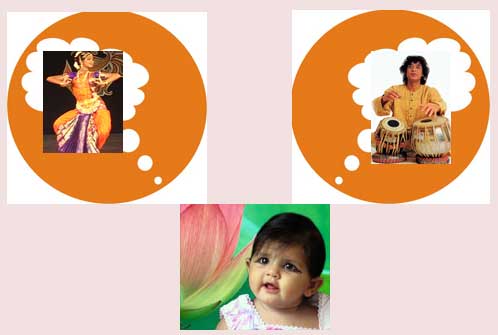
Archives
Contribute
| South Asian Art - In Memory Of Prashant H. Fadia |
Ranjani Saigal
07/08/2008
Music and dance are an integral part of life to many South Asians. From the days of the Natya Shastra when different kinds of performances predominately performed in the Mandapams in the temple or on makeshift stages in villages to the present day when the silver screen has taken over as the predominant form of entertainment, the fascination with dance and music has been everlasting.
For many growing up in India the training in music and dance depends heavily on the family background. In Tamil Brahmin families classical music training for women was valued so much that until recently every “Pon Parkum Padalam†or the event where the groom’s family came to see a girl to judge her “bride potentialâ€, the girl was expected to sing or play an instrument at the event. Her performance gave her points in the “bride potential†calculations. Yet again until recently in other families formal music and dance training was looked down upon as something that decent women do not indulge in.
Classical arts have a made a curious comeback in the most unexpected of places – North America. Interest in Bharatanatyam has perked thanks the lavish Arangetram performances which have become great party occasions for families wishing to throw a nice party.
The Indian classical dance and music scene got another unexpected supporter – the college admission process which places value on serious training acquired in the classical arts. Suddenly the arts had not just entertainment value but had value, albeit a small one, in increasing the admission to a prestigious school. The fundamental interest in dance and music amongst South Asians coupled with its other unexpected values has made many parents consider providing training in an art form as an important part of the educational process.
So how does one decide which art form to teach the child? How does a parent judge whether child would be interested in Classical Tuba or in Manipuri dance especially at the age of three when the child can barely speak and walk? What is a good age to start training? How does one find a good teacher?
Perhaps because of my experience with teaching or because I raised two children ( a boy and a girl) and provided them with training in Indian and Western classical music I am often asked these questions. For those wanting answers to these questions I always refer them to Dr. Shinichi Suzuki’s Nurtured by Love.
I think there are three guiding principles in the arts.
The first principle is that while there are prodigies, they are very few and far between and most parents of prodigies will tell you that you should be glad you do not have one at home!:-). Most children will be interested in the arts if the parent shows the interest. So pick an art form for your child that you care about. Remember that you have to drive the kid to the lessons, sit through them and watch them practice at home. If you do not like the art form this could be a great pain for you and that pain will be sensed by the kid who will want to withdraw from the class. If you hate Bhangra and love Carnatic classical music make sure you enroll your child in music and not Bhangra classes.
Remember that you can never go wrong in picking an art form. Immaterial of the training they receive, if there is a passion for a particular art they realize later in life, most of the training they have received from one art form will be transferable to another. Art training is really training the brain to think in a particular way and that training will never be lost. Case in point - Prof. John Higgins trained in western music made a big name for himself in the Carnatic music field.. We still have to find people who can sing Chakani Raja better than “John Higgins Bhagavatharâ€.
The second principle is that the interest in the art grows with the knowledge and practice of the art. No parent will ever agree that their child does not need to do “math homework†because he is not interested or the teacher is not good. Yet often parents attribute laziness and lack of art practice to a disinterest in the arts or poor teaching. Most children love arts but putting the time to practice is a challenge and parents should work on guiding the child to put in the hard work needed for the “interest†to grow.
The third principle is the age old principle of “Guru Bhakti†or respect for the teacher. What does this mean in practical terms? It is not a lofty spiritual ideal. Since the art is not familiar to the child, the child must learn to trust that the guidance provided by the teacher is indeed correct. If the parent criticizes the teaching methods of the teacher in the presence of the child, the child will automatically not trust the teacher and will not learn. Respect is to simply listen and follow instructions till you have reached a high level in your training. Then you can question your Guru and bring your own ideas into the art form. Parents who do not know the art form and the training methods may wish to defer to the teacher for that expertise.
In the next issue we will discuss finding the right teacher for your child.
You may also access this article through our web-site http://www.lokvani.com/
